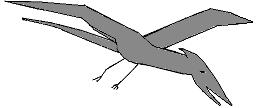I’ve been writing about modern-pterosaur sightings, regarding misidentification potential, for years, with new critics bringing up old objections. Let’s now consider the words of a skeptic who calls himself “Mullerornis.”
“Most pterosaur sightings turned out to be ducks or bats.
“Indeed, many reports fail spectacularly at pterosaur biology. Pterosaurs didn’t had bat-like leathery wings, for starters.”
Ducks?
I have over a hundred sighting reports compiled in a data base that includes many details (wingspan estimate, surety of featherlessness, location of sighting, time of day, presence or absence of tail, etc); it is still expanding, now with year-2012 reports being entered. Let’s consider the skeptic’s remark about ducks, using the data base, since he gives no examples of any particular sightings.
How many sighting reports were kept out of the data base because they “turned out” to have been misidentified ducks? I believe that number is “zero.” How many entries in the data base “turned out” later to have been misidentified ducks? I believe that number is also “zero.” How many reported sightings does this skeptic give to us, that is . . . specific sightings? Zero. The value of his speculation about ducks that look like pterosaurs? You be the judge.
But I found this critic’s addition of “ducks” to the misidentification possibilities interesting. I did communicate, earlier this year, with a man who had a skull of something that appeared to have teeth (he wondered if it might be the remains of a pterosaur). I eventually concluded it was probably the skull of a duck, after careful investigation and many emails between me and the owner of the skull (the photo reminded me of the pseudo-teeth of some ducks). But there was no sighting associated with that skull. In addition, little (if anything) was written about it in cryptozoology blogs. So why did the critic mention “duck?” It must have been something else.
I remembered the nineteenth century newspaper account of a tunnel out of which a strange winged creature was said to have escaped from stone—the French word for “duck” was included in that newspaper article—but that’s irrelevant, for the story was surely a hoax.
I then remembered a sighting in the United States, in which the flying creature dived down to a pond and caught a duck (or other water fowl) in its mouth before flying off with it. But the flying creature that preyed upon that bird was not itself duck-like, so that sighting is also irrelevant. What are we left with, other than the word of a person who calls himself “Mullerornis,” who insinuates that he might know something about some undisclosed sightings in which ducks looked like pterosaurs?
Bats
How outdated that generalization! Even the Monsterquest television episode “Flying Monsters” (2009) was caught in that intellectual trap, as the producers attempted to pin “bat” on flying-creature sightings that serious investigators know could not have been from any bats. They included the account of the “pterodactyl” seen by the American World War II soldier Duane Hodgkinson; but they failed to disclose his estimate of the length of the tail on that flying creature: “at least” ten or fifteen feet long. [sighting in Papua New Guinea]
“Mullerornis” gives us no particular sighting report, not even a hint of anything specific. His credibility fails to impress me enough to continue writing about the “bat” misidentification speculation. Read any of my three nonfiction books on modern pterosaurs.
Did Pterosaurs Have Bat-Like Leathery Wings?
The skeptic seems to have made the same mistake that I encountered from a paleontologist with whom I was communicating. Beware of the paleontologist who steps outside his field of expertise to speculate about eyewitness accounts. Let’s look into this.
Most flying creatures larger than butterflies we call “birds.” When an eyewitness of an apparent living pterosaur describes it, the word “bat” sometimes comes out. Closer examination, if the skeptic “Mullerornis” had looked closer, reveals why an eyewitness would say “bat-like.” The flying creature appeared to have no feathers. That’s it.
In general, when an eyewitness says something like “bat-like,” details in the description make it obvious that the creature was no bat. But the person viewing the apparent pterosaur did not notice details in the bones in the wings and use the word “bat” because of the fanning out of bat “fingers” in the wings. With few, if any, exceptions, the point is this: lack of feathers. We usually associate that with bats, when the subject is flying creatures (larger than butterflies) living today, so large featherless flyers remind us of bats.
When the word “leather” is used by an eyewitness, we need to remember what happened. The person did not examine a flying creature in a laboratory, like a paleontologist would do with a fossil. It was an observation at a distance, for most sightings involved being more than twenty feet away (on occasion, closer). The combination of lack of feathers and a general color similar to leather could easily cause an eyewitness to say “leathery.” The precise nature of pterosaur skin is irrelevant.
It’s that simple. The proclamations of this critic have no foundation.
.
So who do you call? I hope you’ll contact me, Jonathan Whitcomb. As far as I know, I am the only person on earth who has devoted anything like a full-time effort, over years, to interview eyewitnesses of apparent living pterosaurs and promote the concept that these flying creatures are not extinct . . .
. . . to document, then analyze, eyewitness accounts of living pterosaurs or pterosaur-like creatures and to support expeditions and investigations . . .
The French railway-tunnel pterodactyl of 1856 is finally getting its obituary, albeit The Illustrated London News has no such obituary. [The report appears to have been a hoax.]



